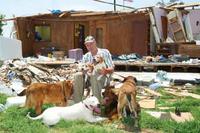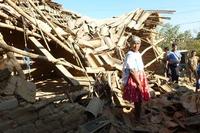-
Wisconsin county has a new LMR system
In Rock County, Wisconsin, firefighters have been required manually to change radio channels as they moved from North to South because of two different frequencies in the region; Raytheon is helping to combine three disparate communications systems in the country into one; the result will be more efficient – and interoperable – first response communication system
-
-
Efficiency of multi-hop wireless networks boosted
Multi-hop wireless networks can provide data access for large and unconventional spaces, but they have long faced significant limits on the amount of data they can transmit; now researchers have developed a more efficient data transmission approach that can boost the amount of data the networks can transmit by 20 to 80 percent
-
-
San Francisco earthquake planners developing pet-disaster response

San Francisco is preparing for the Big One in more ways than one: the latest addition to the city’s disaster preparedness plans is a legion of pet disaster responders, trained by city officials to rescue pet dogs, cats, rodents, birds, and reptiles in the event of a disaster, and transport them to one of 125 temporary shelters
-
-
More efficient bioterrorism response plan
In the event of a bioterror attack on a building (think: the 2011 anthrax attack on the offices of two Democratic Senators, Tom Daschle of South Dakota and Patrick Leahy of Vermont), the current approach to decontamination is to clean up the building until no pathogens can be detected; researchers suggest, however, that whether or not pathogens are found depends greatly upon how extensively the buildings are tested
-
-
DARPA offers $2 million in prizes for Robotic Challenge winners
DARPA is seeking hardware, software, modeling, and gaming developers to link with emergency response and science communities to design robots capable of supervised autonomous response to simulated disaster
-
-
DHS cuts grants to states, emphasizes maintenance

Over the past few years, DHS has been cutting funding for grants to state and emergency response agencies; the billions of dollars given to states after 2011 have been used to buy many pieces of first-response and law-enforcement equipment, and DHS now emphasizes the maintenance of that equipment
-
-
Mexico has an earthquake warning system, why not California?

Mexico has a functioning and apparently life-saving earthquake warning system in place; California’s system is stuck in a permanent test phase due primarily to lack of funding
-
-
Robot jellyfish for underwater search and rescue
Researchers have built a robotic swimmer that mimics the motion of a jellyfish; the device will because for underwater search and rescue missions
-
-
County experiments with new medical emergency dispatch protocol

In an effort to reduce costs and free up valuable resources, Kings County, Seattle is experimenting with a new 911 emergency call system that prioritizes emergency calls over nonemergency calls; under the new system, when residents call 911 with a serious medical emergency, the system will dispatch a fire truck or ambulance
-
-
The Red Cross, emergency response, and Twitter
Social media has become such an integral part of our lives that emergency responders are now turning to Twitter and Facebook to gain valuable information during natural disasters or crises
-
-
Researchers developing wireless emergency network for disasters
University of Arkansas researchers are developing a solar powered wireless emergency communications network that can be deployed during major disasters to transmit critical warnings and geographic information
-
-
Tighter regulation of industry’s disaster preparedness required
Before 11 March 2011, Japan was held up as a paragon for preparedness; they had a national readiness plan, regular disaster drills, and strong civic engagement; the Fukushima disaster exposed a disturbing reality: search and rescue efforts were delayed, shelters ill-equipped, and supply chains broken; worst of all, there was confusion about who was managing the nuclear accident — the power company TEPCO or the Japanese government; information, when forthcoming, was sometimes contradictory
-
-
GAO: new emergency responder network lacks critical features
A recent Government Accountability Office (GAO) report concludes that limitations in the government’s plans to create a nationwide broadband network for first responders will require the continued use of the existing system for at least another decade
-
-
Reliable communications during natural disasters, emergencies
The Contingency Response Communications System (CRCS) is easily set up within thirty minutes. Once set up is complete the CRCS allows emergency first responders quickly to communicate with military commanders through phone or Internet
-
-
Detroit prioritizes how its responds to 911 calls
With the help of a newly created unit, Detroit Police are changing how they respond to emergency calls; under the new system, officers will be able to respond to the most immediate threats first before dealing with non-emergency requests
-
More headlines
The long view
The Surprising Reasons Floods and Other Disasters Are Deadlier at Night
It’s not just that it’s dark and people are asleep. Urban sprawl, confirmation bias, and other factors can play a role.
Why Flash Flood Warnings Will Continue to Go Unheeded
Experts say local education and community support are key to conveying risk.
